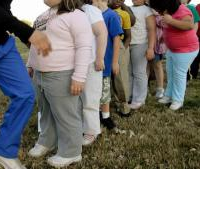Cuts in Phys Ed Take Toll: Only One-Third of California Students Are Fit
 (photo: Matt Slocum, Associated Press)
(photo: Matt Slocum, Associated Press)
Who could have predicted that if California scaled back physical education in K-12 schools and let more than a third of its students skip out altogether that the state would have a lot of overweight, poorly-conditioned kids on their hands?
Ok, the answer is everyone, and their genius has been confirmed by a new study which found that only around one-third of students in fifth, seventh and ninth grades were physically fit. The California Department of Education tried to put a good spin on the numbers in its press release—“California Students Make Slight Gains in Physical Fitness”—but the bar for success was pretty low.
Only 37% of ninth-graders scored in the “Healthy Fitness Zone” for all six areas, and they were the fit ones. Only 32% of seventh-graders and 26% of fifth-graders were in the zone. The tests measured flexibility, aerobic capacity, abdominal strength, trunk extensor strength, upper body strength and body composition.
That last category was the foundation for kids being sent home with “fat letters” informing them and their parents that the kids were obese. California is one of 19 states that screens for obesity and the department requires that students be made aware of the test results. Individual school districts can require that the results be sent home.
Critics of the notification fear that students will be ostracized at school and develop eating disorders, like bulimia or anorexia nervosa, to keep weight off. Proponents point out that the Centers for Disease Control and Prevention (CDC) says childhood obesity rates have more than doubled in children and tripled in adolescents over the past 30 years.
A 2010 study published in the Journal of Pediatrics found that unfit California students in fifth, seventh and ninth grades get lower scores on standardized tests. The report pointed out that “the suggestion that physical activity and other lifestyle behaviors may affect brain functions such as learning, memory and decision-making is largely untested.”
Although budget cuts over the years have taken a heavy toll on school PE programs, they are not the only in-school contributor to student physical inertness. A study (pdf) by the UCLA Center for Health Policy Research in 2011 found that 38% of California students managed to dodge phys ed altogether. The study based its conclusions on data drawn from a 2007 survey of 3,600 adolescents.
California requires a little more than three hours of physical education a week for students. But PE can involve a range of activities and the report estimated that less than 20% of the time in PE classes at the middle and high school levels was actually spent in physical activity. And exemptions could be had for any number of reasons, including participation in driver’s education—the acquirement of which is almost certain to lead to even less physical activity.
–Ken Broder
To Learn More:
California Schools’ Fitness Tests: About One-Third of Students Met the Goals (by Theresa Harrington, Contra Costa Times)
California Students Fall Short on Physical Fitness Test (by Nadra Nittle, Inland Valley Daily Bulletin)
Despite State Law, Teens Miss out on PE (by Erica Perez, California Watch)
Adolescent Physical Education and Physical Activity in California (by Allison L. Diamant, Susan H. Babey and Joelle Wolstein, UCLA Center for Health Policy Research) (pdf)
“Fat Letters” Outrage Some California Parents (by Michelle Castillo, CBS News)
California Students Make Slight Gains in Physical Fitness (California Department of Education)
Low Aerobic Fitness and Obesity Are Associated with Lower Standardized Test Scores in Children (by Christian K. Roberts, Benjamin Freed and William J. McCarthy, National Institute of Health)
- Top Stories
- Controversies
- Where is the Money Going?
- California and the Nation
- Appointments and Resignations
- Unusual News
- Latest News
- California Forbids U.S. Immigration Agents from Pretending to be Police
- California Lawmakers Urged to Strip “Self-Dealing” Tax Board of Its Duties
- Big Oil’s Grip on California
- Santa Cruz Police See Homeland Security Betrayal in Use of Gang Roundup as Cover for Immigration Raid
- Oil Companies Face Deadline to Stop Polluting California Groundwater





